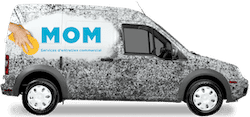The most frequent commercial cleaning mistakes include untrained staff, improper use of cleaning products, incorrect cleaning frequency, neglect of “invisible” areas, non-compliance with hygiene regulations, poor communication, and the absence of regular quality checks.
These failures come at a high cost — health risks, damaged reputation, and regulatory non-compliance.
By choosing a meticulous provider like MOM Cleaning, you minimize these risks and ensure a professional, compliant, and hygienic workplace.
Why Commercial Cleaning Is Strategic for Your Business
Hygiene, Image, and Safety: The Core Priorities
A well-maintained environment helps reduce the spread of germs and infections while reinforcing trust among employees, clients, and visitors.
Poorly maintained spaces harm your organization’s image and credibility.
Consequences of Poor Cleaning
- Increased employee sick leave
- Customer complaints or dissatisfaction
- Regulatory non-compliance or penalties
- Extra costs for repairs or corrective cleaning
The 7 Most Common Commercial Cleaning Mistakes
1. Lack of Staff Training
Untrained employees may not know proper techniques (cleaning order, dilution, surface sequencing), leading to poor results or cross-contamination.
2. Improper Use of Cleaning Products
Using incompatible or overly concentrated products can damage surfaces, leave residues, or create health hazards.
Follow the Canadian Centre for Occupational Health and Safety (CCOHS) and CNESST guidelines for safe and compliant use.
3. Poorly Planned Cleaning Frequency
Cleaning too little or too often wastes time and resources. Frequency should match usage levels — high-traffic zones like lobbies require more frequent maintenance.
4. Neglecting Low-Visibility Areas
Areas like under furniture, baseboards, light fixtures, or air vents often get overlooked but accumulate dust, microorganisms, and allergens.
5. Non-compliance with hygiene and regulatory standards
Failing to meet hygiene requirements (especially in washrooms and personal spaces) can lead to legal risks. For instance, the Canada Occupational Health and Safety Regulations (SOR/86-304) require that every sanitary facility be cleaned at least once per day of use, that waste containers be emptied daily, and that waste be stored hygienically.
6. Poor communication between client and service provider
A lack of clarity in the contract (areas to clean, schedules, frequency, quality criteria) leads to misunderstandings and unmet expectations.
7. Absence of regular quality control
Without audits, inspections, or checklists, maintaining consistent quality becomes difficult. Unexpected issues or declines in performance often go unnoticed for too long.
Official standards and best practices to follow
Hygiene standards in Canada and Quebec
The Canada Occupational Health and Safety Regulations (SOR/86-304) outline the minimum requirements for sanitary rooms, waste containers, and hygienic working conditions.
The Public health cleaning and disinfection guidelines provide adaptable principles for all settings: clean first, then disinfect, using the right products at the right time.
Sectoral guidelines and standards
The Canadian Centre for Occupational Health and Safety (CCOHS) Workplace Housekeeping Guide explains why proper workplace upkeep is essential.
How to avoid these mistakes with a reliable partner like MOM Cleaning
Quality and compliance approach
MOM Cleaning establishes cleaning protocols that comply with governmental and industry standards, ensuring traceability and regular audits.
Trained and supervised teams
All employees receive training on cleaning techniques, safe product use, safety procedures, and regulatory compliance.
Customized plans and quality control
Each client receives a tailored plan (frequency, surfaces, type of use). Periodic inspections and checklists ensure quick corrections when needed.
Useful links to learn more about our services
→ Discover our commercial cleaning services.
FAQ – Commercial Cleaning: Mistakes and Prevention
Q1: What is the minimum cleaning frequency required for washrooms under Canadian law?
According to the Canada Occupational Health and Safety Regulations (SOR/86-304), every personal facility (toilet, sink) must be cleaned at least once per day of use.
Q2: Why are hidden areas important in a cleaning plan?
They accumulate dust, microbes, and allergens. Neglecting these areas reduces the overall cleaning efficiency and may cause complaints or health issues.
Q3: How does MOM Cleaning ensure consistent quality?
Through regular audits, priority checklists, ongoing training, and strict compliance with standards.
For questions or to request a quote, contact us.




